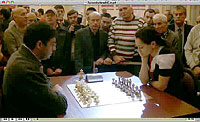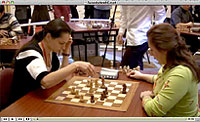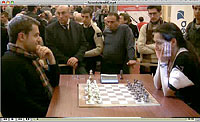Norway Chess 2013 Round 1: Karjakin, Nakamura, Svidler Begin with Wins
Chess blog for latest chess news and chess trivia (c) Alexandra Kosteniuk, 2013
Hi everyone,
As the tournament will be played with nine rounds in eleven days and true quality time limits, Norway and the rest of the chess world for sure can look forward to many great games this week. The tournament made a fresh start this afternoon, with four of out five games lasting more than four hours – and three of them getting a winner.
To tell the truth, World Champion Viswanathan Anand made a very solid but not very frightening start on this Norwegian chess adventure. Playing white in a closed Ruy Lopez against second seeded Levon Aronian, the chess star from India played a rather slow and closed set up with an early c4. The ambitious Armenian (of course) did not hesitate to jump in at the outpost d4 with one of his knights before move 10. Three set of minor pieces were exchanged within five moves afterwards, leaving a fairly balanced position with queen, rooks, different colored bishops and eight pawns on each side. Something finally seemed about to happen as Aronian played 22.— Bh6!?, intending to answer 23.Qh4 with a tactical 23.— Bxf4 – as played. Some spectators wondered (creatively) whether the World Champion was planning to sacrifice his queen for rook and bishop, but Anand instead (wisely) exchanged some more pieces to regain the pawn he gave up on f4. In the endgame with rook and six pawns versus rook and six pawns, Aronian at move 29 placed his rook on the seventh rank and for a few minutes seemed close to something. Anand however remained laidback and still was not in any real danger. As black could never accept to exchange rooks, it all dried out with two rooks following each other around to a repetition of moves after 33 moves.
The second game to finish was the slowest start, as Sergey Karjakin spent much time as white and Teimour Radjabov even much more time as black in their internal youngster meeting. Only 14 moves were made on the board after two and a half hours had passed on the clock, and continuing in the same slow speed, Radjabov two moves later had only eight minutes left to reach the time control after 40 moves.
On the board was a closed Sicilian line with 4.Bb5, in which white came a little better after black played 5.— e5 followed by 7.— h6. Although black got a nice outpost for his knight on d4, white playing with a guarded passed pawn at d5 appeared somewhat better after 20 moves. While Karjakin methodically increased the pressure with a queenside attack, Radjabov somehow somewhere mixed up the critical lines and lost a pawn just before 30 moves. Defending with rook and bishop versus rook and knight, black still had some drawing chances, but having only seconds left he lost another pawn just before 40 moves. In the end Radjabov threw out his move 39 with two seconds left and his move 40 with nine seconds left on the clock – only to resign instead of making his move 41, as Karjakin’s 41.c5! demonstrated the rook endgame on the board to be won. No way a promising start for Radjabov on the third tournament following two nightmare results, while Karjakin looked relaxed and inspired at the same time today.
Less relaxed but all the more inspired (as usual) was the United States representative, colorful Hikaru Nakamura. Facing a solid Russian opening from Chinese opponent Hao Wang, white bravely castled long to go for a kingside attack. Objectively speaking black was perfectly fine from the opening, but white still got an initiative following a probably inaccurate manoeuver with 15.— Re4 and 16.— Re6. Having weakened his kingside with h6, Wang felt forced to exchange queens at the cost of a pawn. Sacrificing two minor pieces for a rook later on was a creative try from a Chinese point of view. Although the computer programs gave black some drawing chances, the endgame with rook and six pawns versus knight, bishop and six pawns for most present human beings still looked difficult at best. Anyway Wang too lost the thread on the board when running short of time on the clock, and the outcome became obvious as white got an octopus knight on e6 while black still had no open line for his rook. Wang too survived the time trouble, having seven seconds left after making his move 40 – but the new time only helped him to realize that his position was lost behind all reasonable doubt. Nakamura definitely is a potential hit man also in this tournament, remaining to test out whether he will hit only his opponents or also himself in later rounds…
An isolani pawn on d5 gave white some more chances, but at the same time he had to watch out not to overstretch. Some Norwegian spectators claimed they saw some light just before 40 moves, as white apparently was about to get a dangerous attack in the h-file (which black had been helpful to open up a few moves earlier on). A top concentrated Topalov however walked confidently around on the water, and it turned out white had nothing better than exchanging rooks. Just after 40 moves some Bulgarian chess fans on internet claimed they saw some light, as Topalov won the d5-pawn in the knight endgame. It however soon turned out that white’s active king was too disturbing for black to reach any winning chances even with an extra pawn, and Topalov returned the pawn while offering a draw after 51 moves. A waiting start both for the former rating king and the former World Champion, but still under the surface a very interesting game.
Seeded more than 100 points below the ninth rated player in this field, Jon Ludvig Hammer obviously is the underdog among the wolves this week. Still he started barking immediately, being ahead on the clock and probably equal on the board after 15 moves as black against Russian chess star Peter Svidler in a well known Grünfeld exchange line. Without the queens white kept a slight queenside initiative, but black defended creatively when sacrificing a pawn on b6 to win back another pawn on e4. Being a patient player with a magnificent technique, Svidler still played on for a win as white. He was partially rewarded as Hammer made some inaccuracies when entering the rook and minor piece endgame, forcing himself to give up a pawn in the rook endgame. Still these rook endgames, with three kingside pawns for both players and an extra a-pawn for white, usually is drawn if black can place his rook beside the a-pawn and cut off the white king – like Hammer did from the start in this endgame.
Still there was some play left in the position, and Hammer probably made the decisive mistake when he just before 40 moves put his king out in the thin air at f6 instead of just waiting and smoking on g8. Svidler (of course) used his chance, instructively opening up the kingside with h4-h5 to win another pawn and the game before 60 moves. A very honest loss still was a difficult start for Hammer. While Svidler following a slow but successful start, no way should be underestimated by anyone in this tournament either…
In short: Karjakin, Nakamura and Svidler are sharing the lead at +1 – so far. Still much to learn and discuss from the games from round one while we are waiting for round two – including the much expected game between World Chess Challanger Carlsen and World Chess Champion Anand!!
From Alexandra Kosteniuk's
www.chessblog.com
Also see her personal blog at
www.chessqueen.com
Don't miss Chess Queen™
YouTube Channel
Labels: anemone kulczak, hans olav lahlum, Hikaru nakamura, jon ludvig hammer, levon aronian, Magnus Carlsen, norway chess super tournament 2013, peter svidler, sergey karjakin, veselin topalov, Viswanathan Anand






































0 Comments:
Post a Comment
Note: Only a member of this blog may post a comment.
Subscribe to Post Comments [Atom]
<< Home